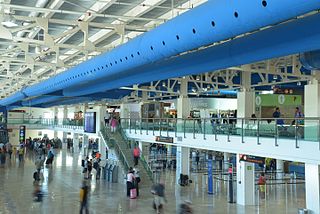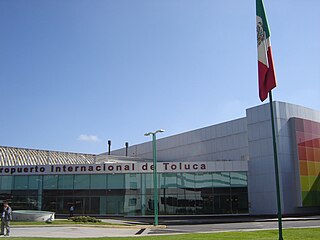
Mexico City International Airport ; officially Aeropuerto Internacional Benito Juárez is the primary international airport serving Greater Mexico City. It is the busiest airport in Mexico and Latin America, ranking as the 17th-busiest in the world and eighth in North America as of 2022, based on passenger traffic and aircraft movements.

Tijuana International Airport ; officially Aeropuerto Internacional General Abelardo L. Rodríguez, is an international airport located 5 km (3.1 mi) northeast of downtown Tijuana, Baja California, Mexico. It serves Tijuana and the surrounding San Diego–Tijuana metropolitan area, home to a population of five million people.

Miguel Hidalgo y Costilla Guadalajara International Airport, simply known as Guadalajara International Airport, is the primary international airport serving Guadalajara, Jalisco, the third-largest city in Mexico. It facilitates flights to and from destinations across Mexico, the Americas, and Europe. It is the largest hub for Volaris, functioning as the airline's primary gateway to the United States. Additionally, it serves as a hub for Aeromexico and Viva. Operated by Grupo Aeroportuario del Pacífico (GAP), the airport is named after Miguel Hidalgo, a prominent leader in the Mexican War of Independence.

General Mariano Escobedo International Airport, simply known as Monterrey International Airport, is an international airport located in Apodaca, Nuevo León, Mexico serving Greater Monterrey. It operates flights to Mexico, the United States, Canada, Latin America, Asia and Europe. The airport serves as the main hub for Viva, Magnicharters, and the regional carrier Aerus. It is also a focus city for Volaris, Aeromexico Connect, and the regional airline TAR Aerolíneas. The airport also serves cargo and charter flights, hosts facilities for Mexican Airspace Navigation Services, and facilitates various tourism-related activities, flight training, and general aviation. Monterrey Airport is operated by Grupo Aeroportuario Centro Norte OMA and it is named after General Mariano Escobedo, a prominent military figure born in Nuevo León.

Juan Santamaría International Airport is the primary airport serving San José, the capital of Costa Rica. The airport is located in Alajuela Province, 20 kilometres northwest of downtown San José. It is named after Costa Rica's national hero, Juan Santamaría, a drummer boy who died in 1856 defending his country against forces led by William Walker, an American filibuster. It is the biggest and busiest airport in Costa Rica and second in Central America with more than 5 million passengers per year before COVID.

Licenciado Gustavo Díaz Ordaz International Airport (IATA: PVR, ICAO: MMPR), simply known as Puerto Vallarta International Airport, is an international airport serving Puerto Vallarta, Jalisco, Mexico. It serves as a gateway to the Mexican tourist destination of Riviera Nayarit and the Jalisco coast year-round, offering flights to and from Mexico, the United States, Canada, and the United Kingdom. The airport also houses facilities for the Mexican Army and supports various tourism, flight training, and general aviation activities. Operated by Grupo Aeroportuario del Pacífico, it is named after President Gustavo Díaz Ordaz.

León/Bajio International Airport ; officially Aeropuerto Internacional de Guanajuato, is an international airport situated in Silao, Guanajuato, Mexico. It is the main international airport serving the Greater León Metropolitan Area and the State of Guanajuato, which is home to a population of 6 million residents, including the cities of Celaya, Guanajuato, Irapuato, Salamanca, and San Miguel de Allende. In addition to offering domestic flights within Mexico, it serves as a gateway for international travel, connecting Central Mexico to various destinations in the United States. It serves as a focus city for Volaris and supports flight training, cargo, logistics and general aviation activities.

Mérida International Airport, officially Aeropuerto Internacional Manuel Crescencio Rejón, is an international airport located in the Mexican city of Mérida. It serves as the primary international gateway to Mérida and the State of Yucatán, a popular tourist destination, offering flights to and from Mexico, the United States, Canada, Central America, and the Caribbean. The airport also accommodates facilities for the Mexican Airspace Navigation Services, and the Mexican Army, and supports various tourism, flight training, and general aviation activities. Additionally, it serves as a focus city for Viva.

Oaxaca International Airport(Spanish: Aeropuerto Internacional de Oaxaca) officially Aeropuerto Internacional Xoxocotlán(Xoxocotlán International Airport)(IATA: OAX, ICAO: MMOX) is an international airport located in the municipality of Santa Cruz Xoxocotlán, a southern suburb of Oaxaca City, Mexico. It handles national and international air traffic for the Metropolitan Area of Oaxaca and a significant portion of the State of Oaxaca. The airport is operated by Grupo Aeroportuario del Sureste (ASUR) and derives its name from the Nahuatl word "xocotl," meaning "sour or sweet and sour fruit."

Cozumel International Airport is an international airport in the Caribbean island of Cozumel, Quintana Roo, Mexico. It handles national and international air traffic for the city of San Miguel, Cozumel and serves as a year-round secondary gateway for Mexican Caribbean and Riviera Maya tourism. The largest airport in the region is Cancún International Airport located in mainland Quintana Roo about 60 kilometres (37 mi) to the north of Cozumel.

Veracruz International Airport (Spanish: Aeropuerto Internacional de Veracruz Heriberto Jara); officially Aeropuerto Internacional Heriberto Jara(General Heriberto Jara International Airport) (IATA: VER, ICAO: MMVR) is an international airport located in Veracruz, Mexico. It handles national and international air traffic for the Metropolitan Area of Veracruz and a significant portion of the State of Veracruz, including the metropolitan areas of Córdoba, Orizaba, and Xalapa. The airport is named in honor of General Heriberto Jara, a Constituent Deputy and former Governor of Veracruz. It is operated by the Grupo Aeroportuario del Sureste (ASUR).

Villahermosa International Airport ; officially known as Aeropuerto Internacional Carlos Rovirosa Pérez(Carlos Rovirosa Pérez International Airport) is an international airport located in Villahermosa, Tabasco, Mexico. It serves the Metropolitan Area of Villahermosa, the entire State of Tabasco, and Northern Chiapas. The airport offers domestic flights within Mexico and supports various tourism, flight training, and general aviation activities. It is named in honor of Carlos Rovirosa Pérez, a pioneer of Mexican aviation, who was born in Villahermosa. The airport is operated by Grupo Aeroportuario del Sureste (ASUR). In 2021, the airport handled 1,214,190 passengers, and in 2022, it served 1,396,653 passengers, an increase of 15.03% according to ASUR.

Huatulco International Airport is an international airport located in Santa María Huatulco, in the State of Oaxaca, Mexico. The airport manages both domestic and international air traffic for the southern and southeastern Pacific coast of Oaxaca, and it serves as an international gateway to the Mexican tourist destination of Huatulco and the Costa Region of Oaxaca. The airport is owned by Aeropuertos del Sureste (ASUR).

Ciudad Juárez International Airport ; officially Aeropuerto Internacional Abraham González(Abraham González International Airport) is an international airport located in Ciudad Juárez, Chihuahua, Mexico, near the Mexico–United States border. It serves the Metropolitan Area of Ciudad Juárez and the El Paso-Juárez agglomeration. The airport serves multiple domestic destinations and also supports cargo flights, flight training, and general aviation activities. It is named after Abraham González, a former Governor of the State of Chihuahua.

Chetumal International Airport is an international airport located in Chetumal, Quintana Roo, Mexico, near the Belize–Mexico border. It serves domestic flights for Chetumal and the southern Quintana Roo region, while also supporting various executive and general aviation activities, and hosting Mexican Navy facilities. Since 2023, the airport has been operated by Grupo Olmeca-Maya-Mexica (GAFSACOMM), a holding company owned by the Mexican military. In terms of traffic, the airport handled 374,152 passengers in 2022, decreasing to 335,088 passengers in 2023.

Tapachula International Airport is an international airport located in Tapachula, Chiapas, Mexico, near the Mexico–Guatemala border. It serves the Metropolitan Area of Tapachula and the Soconusco region, facilitating multiple domestic destinations, flight training, and general aviation activities. Operated by Grupo Aeroportuario del Sureste (ASUR), it holds the distinction of being the southernmost airport in Mexico. In 2022, it served 503,254 passengers, and this number increased to 553,744 passengers in 2023.

Toluca International Airport ; officially Aeropuerto Internacional Licenciado Adolfo López Mateos(Licenciado Adolfo López Mateos International Airport) is an international airport in Toluca, State of Mexico, Mexico. It handles both national and international air traffic for the Metropolitan area of Toluca and serves as a secondary airport for Greater Mexico City, alongside Felipe Angeles Airport. Historically serving as a hub for Volaris, Interjet, and Republicair, the airport is operated by Administradora Mexiquense del Aeropuerto Internacional de Toluca and is named after President Adolfo López Mateos.

Tuxtla Gutiérrez International Airport, officially known as Aeropuerto Internacional Ángel Albino Corzo, is an international airport situated in the municipality of Chiapa de Corzo, Chiapas. It serves air traffic for Tuxtla Gutiérrez and a significant part of the State of Chiapas, including San Cristóbal de las Casas and Comitán.

Palenque International Airport is an international airport in Palenque, Chiapas, Mexico. It serves international air traffic for the northern Chiapas region, including Palenque, serving domestic flights and supporting tourism, flight training, and general aviation activities.

Tulum International Airport – officially the Felipe Carrillo Puerto International Airport – is an international airport situated approximately 20 kilometres (12 mi) southwest of Tulum, Quintana Roo, Mexico. It serves both domestic and international air traffic for Tulum, functioning as a secondary gateway for tourists visiting the Mexican Caribbean, the Riviera Maya, and the Yucatán Peninsula. It also supports various executive and general aviation activities. The primary airport in the region is Cancún International Airport, situated approximately 125 kilometres (78 mi) north of Tulum.














































